The following transcript was completed by Jerry Berkman, as described below. It was originally posted at http://election-reform.org/dan_rather.html, but that page is no longer available, so we rescued his transcript from the Internet Archives to post below.
Dan Rather's actual video report, as transcribed below, is available to watch here. - Brad Friedman (9/27/2014):
This is a transcript of Dan Rather's hour long report on HDnet titled "The Trouble with Touch Screens". The first half is about ES&S iVotronic touch screens; the second half is about poor quality paper used for ballots in Sequoia optical scanners in Florida in 2000 and intentional changing of the specs for the ballots for Palm Beach County, Florida, which caused many of the hanging chad, dimpled chad, etc. problems.
This transcript is based on the transcript posted in all caps on the HDnet web site. Kathy Dopp converted it to mixed case. Then the video became available on the HDnet site, and I started looking at that, and decided to add who is speaking to the transcript; I also found material in the video not included in the transcript, such as the interview with Michael Shamos. I have indicated material not in the HDnet transcript, but in the video, and vice-versa, by using italics. There were a number of minor differences between the video and the transcript; the text below is that of the video. Update: I can no longer find the original HDnet transcript on the web.
Contents:
- Intro Teaser/Promo
- ES&S: Shoddy parts for iVotronics since 2001
- Interview with Prof. Michael Shamus, Carnegie Mellon University
- Sequoia: Switched to substandard paper ballots for 2000 Presidential Election
- Sequoia: Intentionally misaligned ballots for Palm Beach County for 2000 Presidential Election
Top
Intro Teaser/Promo:
0:20 Dan Rather: Tonight the trouble with touch screens.
Gene Hinspeter: Even if it's just off a 1/4 of an inch it can throw a vote upper or lower to the other candidate and you have the wrong selection and you really don't realize it.
Dan Rather: The story of companies that built thousands of new age voting machines for elections all across America with touch screens that were unreliable
Landen Tuggle: We were rejecting at the time, Anywhere from 30-40% of the touch screens that came in.
Dan Rather: Wait a minute, you were rejecting, at that time 30-40% of the touch screens you were getting in from Bergquist?
Landen Tuggle: That's correct.
Dan Rather: Also tonight, the paper trial.
Greg Smith: And I think that everybody's opinion was this 2000 election was going to be our demise, because of the poor quality that we put out the door.
Dan Rather: Workers responsible for making paper ballots that led to the Florida fiasco of 2000 tell their story for the first time.
Giles Jensen: It's a sad state of affairs that it takes 7 years for somebody to actually ask the question to the people that might have the answer.
Dan Rather: A special investigative report on the machines that count America's votes tonight on Dan Rather reports.
Top
ES&S: Shoddy parts for iVotronics since 2001
1:45 Dan Rather: Good evening, from West Palm Beach, Florida. Nothing is more fundamental to the story of America, and what it means to be an American, than the vote. A free people, voting with the guarantee of a secret ballot, holds a privileged place among our most cherished civic institutions. Voting also represents an exercise in faith--a faith that after one drops one's ballot in a box, or pulls a lever, or presses a button on a screen, one's vote will be counted. Recent elections have sorely tested our American faith in the sanctity of the vote. Few places in the country symbolize this strained faith more than the building behind me, the Palm Beach county courthouse, scene of some of the fiercest fights during the 2000 election mess in Florida. But that contest seven years ago is by no means the only one that has raised questions and some of the measures that resulted from that episode, such as new voting machines, have spawned questions of their own.
Christine Jennings: Today (applause). I am proud to announce that I am a candidate for Congress for 2008. (cheering)
Dan Rather: This is Christine Jennings. In November of 2006 she lost the House race for Florida's 13th Congressional district. But Jennings, a Democrat, is already back--running again.
Christine Jennings: I will fight every single day for the privilege of being the people's representative for district 13.
Dan Rather: She lost the 2006 race by a only few hundred votes. But her defeat made headlines, not because of votes counted, but because of votes that may not have been counted at all. Mysteriously, 18,000 voters in Sarasota County, about 13% of all voters there, appeared to have cast no votes at all in the race for this seat in the House of Representatives. This rate of so-called under-votes was much higher than for other counties in the Congressional district.
(screen shows map marked with Manatee 2,324 (2.4%), Charlotte 225 (2.5%), Sarasota 18,412 (12.9%))
Jennings didn't believe that thousands of voters had intentionally not voted in her race. She blamed the touch screen voting machines and she had her reasons.
Christine Jennings: On the first or second day of early voting, we started getting calls from voters telling us there was a problem with the screen, with them trying to vote for me on the review screen. And in addition, voters here called the Sarasota herald tribune, they called the radio stations. Voters, we have hundreds of voters that signed affidavits that said, "those machines did not work properly."
Dan Rather: Those "machines" were the "iVotronic" touch screen voting machine manufactured by Election Systems & Software Of Omaha, Nebraska. ES&S, which claims to be the world's largest election systems provider, is privately held. The company says that over 67 million voters cast their ballots on ES&S equipment last November, in some 22 states. And just after Election Day many voters in Jennings' race said something wasn't right with the voting machines.
5:10 Voter #1: When I went to review my vote, the 13th district came up as I didn't vote.
Voter #2: I went to check it and her name wasn't there.
Voter #3: I hit the square, the "X" came up, I continued voting down to the end, went to the review page, it wasn't on there, it wasn't there.
Voter #4: It came up that Christine's vote did not go through.
Voter #5: I'm hoping that my vote did get counted.
Some guy: 18,000 votes missing is a big mistake and a big error for this county and it should be corrected.
Dan Rather: Jennings sued the state and ES&S, saying the machines had malfunctioned. She never conceded the race and filed an election challenge with the U.S. House of Representatives.
Christine Jennings has made a career out of insisting that numbers be right. She had started out as a bank teller in Ohio, moved to Florida and eventually founded her own bank in Sarasota. Running for Congress was her first venture into politics.
06:00 Christine Jennings: The one thing that I want - it's very simple - the truth, the truth about what happened in this election.
Dan Rather: Jennings' race wasn't the first time serious questions had been raised about the iVotronics.
Voters all over the country had complained that these voting machines had registered their selections incorrectly. Besides Florida, problems with recording votes on the iVotronics were reported in Pennsylvania, Arkansas, Ohio, Indiana, Missouri, And Texas. Just in the last election.
But there may have been a special problem in Florida in 2006. ES&S had sent Florida election officials a memo that summer, warning of a software glitch that could cause misvoting, and saying the company would fix the problem. Surprisingly, neither ES&S nor the state did anything to resolve the problem before the November election. Sarasota didn't even post warning signs for voters in the polls, which ES&S had provided. Still, a state-sponsored audit concluded the Sarasota machines had worked fine.
So why did 18 thousand people not vote in that house race? Many voting analysts blamed a confusing ballot layout for the undervote but Jennings wasn't buying it. Her case and her cause led to hearings in Congress.
07:30 Senator Feinstein: I am going to ask that the GAO and the National Institute of Standards and Technology really conduct a top to bottom investigation of these particular machines. Christine Jennings was in attendance, bringing her local spotlight to a national problem.
Christine Jennings: And it's at the heart of our democracy and people from across this country have made it clear to me they want to know that their vote counts and they have encouraged me to keep this up so that we get to the place that every vote counts.
Dan Rather: Back in Florida, the Jennings race confirmed what some officials had known for years. Gene Hinspeter has been an elections operations specialist for Lee County, that's the Ft. Myers area, for thirteen years. He discovered a serious problem with the iVotronic voting machines in 2003, which he recreated for us in a demonstration.
08:30 Gene Hinspeter: In 2003 we noticed there was a calibration issue with the iVotronic touch screen and we brought it up to the people that maintain our voting equipment. And this is just a little example of what we saw. If you select the first box, if it is off enough, it would make another selection. It is not exactly where you make your selection at. As you see, I am selecting the top box and this second box is highlighting.
Dan Rather: Lee County returned all 1800 of its iVotronics to ES&S to have screens replaced, but problems continued. For Hinspeter, the machines were a high maintenance headache.
Gene Hinspeter: We started out with two employees when we were doing punch card, and when we switched over to the iVotronic we basically had to triple our staff because the hands-on is just so intense. You know before you let the machine go out, you test it, you calibrate it, you check the date and time. There's so many things that need to be done before it goes out. It's not like you can just pull it out of the rack, throw it in the booth and send it out. We have to bring in a team of people that cast ballots on each one of these machines to make sure that it's working properly.
09:50 Dan Rather: And even after all that, there were still problems.
Gene Hinspeter: It seems like they will work today and tomorrow they might not work. I can use ten of them in a test and then we will go ahead and get ready to send them out after the test and we will check them just before they go out the door and we will find that one is not working properly. So, they are just unreliable in my opinion.
Dan Rather: How could machines that had cost taxpayers millions all over the United States be so unpredictable?
According to ES&S, there are 97,000 iVotronic machines in use across the country! Most of us use touch screens every day. From the ATM machines to the latest in cell phone technology. They have to be right. So what was the problem with these voting machines?Our investigation of the ES&S iVotronic took us not to company headquarters in Omaha, Nebraska, but half a world away.
10:55 Dan Rather: These are the shantytowns of Manila, home to the Teletech factory where, since 1999, Filipino workers have been cranking out touch screen machines that were used in Florida and other states.Some workers came forward to talk to us, but were so afraid of the factory owner that they would speak only from the shadows.
Hidden worker (translation on screen): Of course, we have our jobs.
Of course, he can sue us, or fire us, or whatever. Or do something really bad.
But we also need to let people know what's happening inside the plant.
11:50 Dan Rather: What was happening inside the plant? According to this employee and many others exhausted Philippino workers: rushed production, poor quality.
Hidden worker: Well, when you need to ship them out, you really need to ship out.
When we say it's a reject, no, they will say it's still okay.
It seems they're only concerned with the quantity of machines shipped from the plant.
For example, even with the rejects, they do something to make it work.
Just to make it good enough.
They don't really think about what will happen when someone tries to use it.
That's why we think it's quantity not quality.
Everybody in the factory knows that.
12:35 Dan Rather: It took us nearly two months in Manila to finally persuade one former worker to talk to us in daylight. Eddie Vibar is an electrical engineer who worked at the factory between 1999 and 2002.
Eddie Vibar (translation on screen): Many people do not know that we made those voting machines in the Philippines.
Dan Rather: Vibar says he worked on thousands of voting machines shipped to the United States with what he says was virtually no testing done on them. Originally, a fraction of the machines underwent a so-called vibration test. And what was this quality control test for machines on which Americans would cast hundreds of thousands of votes?
Eddie Vibar: They shake the machine.
If there is something inside the machine like components or screws...
all of that gets shaken around inside the machine as well.
Dan Rather: This manual shake-test, would have been a joke at any quality electronics factory. But Vibar says that even this crude test was only done on a fraction of the machines. Why? Because, Vibar says, management didn't want to slow down production. But almost nothing may have affected the workers or the machines, like the crushing heat and humidity of Manila, in a factory with only a few air conditioners, often broken or turned off. Vibar recalls days when the temperature inside rose to over ninety degrees.
14:00 Eddie Vibar: We really could not work when the heat in the factory got to be too much...
we would lose our concentration while trying to do repairs.
So we would take off our polo shirts...
because it would make it a little cooler.
It's hard to do repairs while you're also holding a fan or a piece of cardboard...
Dan Rather: Americans cast ballots for mayors, senators and even the president on these vital machines! They cost some three thousand dollars apiece. So how did they end up being manufactured here? Like this? Enter factory director, Edwin Ching. The Ching family holds a majority interest in the Manila factory, but also in this American company, Pivot International, a contract engineering firm in Lenexa, Kansas. In 1997 ES&S contracted with Pivot International to make its voting machines. The Chings may seem odd business partners for ES&S. The family has a widely-questioned reputation in Philippine business circles and strong connections in top political circles. The Chings have been sued in the Philippines and investigated there, for their alleged business practices, possible tax evasion, and shoddy real estate developments. They have not been convicted of anything. Meanwhile the family lives in seclusion behind the walls of their compound on Paradise Street
15:30 Dan Rather: Vibar says that while the Chings made millions, their employees got sweatshop pay.
Eddie Vibar: And I also heard that when we going to make the voting machines...
our salaries for working on the voting machines would be four dollarsper hour.
But the actual salary given to the voting machine workers...
was the minimum wage in the Philippines which was $2.15 or $2.50 per day.
Dan Rather: Some of the iVotronic's components come from factories in Taiwan and mainland China, but perhaps the most important component, the screen itself, came from America's heartland: the Bergquist Company in Chanhassen, Minnesota. And it was the American-made screens that began to most concern the Filipino workers, like this former employee.
Former employee (translation on screen): The problem with the iVote is the screen - the screen itself.
It was a materials defect with the touchscreens.
Dan Rather: Back in the states ES&S began falling behind in deliveries of iVotronics. Pivot sent an American, Landen Tuggle, from Kansas to manage the factory.
Landen Tuggle: The factory was fairly dismal at that time. In the basement area where we end up putting a lot of our materials, our inventories and everything, I think I probably hauled 50 dump truck loads of cats and rats and snakes and all types of debris.
Dan Rather: Landen Tuggle is known in manufacturing circles for his success upgrading troubled factories of various kinds to first-class status. He says that he eventually did just that in Manila, but that it took time. The Filipino workers recall Tuggle as the first American to care about them and not just the machines.
Eddie Vibar: Landon's treatment of the Teletech employees was good.
We could come to him with our problems and he acted on them right away.
When we complained that it was too hot inside to work, Landon provided us with an electric fan.
17:35 Dan Rather: They came to Tuggle with problems about working conditions, but also about problems with the machines, especially the screens.
Landen Tuggle: After I got over there, it took me a while to get the Filipinos to open up to me. You have to understand the culture over there. Filipinos don't want to give you bad news. You know what I mean? So each time something failed, they not only hated it, they took it personally. But as we got the lines set up and began the manufacturing, they came to me and said, "Sir, these are no good." I said, "What's the problem?" They said, "Sir, the bubble, they're pillowing."
Dan Rather: They're billowing. What does that mean?
Landen Tuggle: Pillowing. It means that the surface of the touch screen, the plastic or Mylar surface, was not stretched taut. It had a like a bubble or even rolls, two or three rolls to it on the touch screen.
Dan Rather: Did you tell anybody what the Philippine workers had told you?
Landen Tuggle: Yes, I did. I got on the phone. We began to make calls.
Dan Rather: So, you were sounding the alarm as far back as 2001?
Landen Tuggle: Yes. We were rejecting at a time anywhere from 30 to 40 percent of the touch screens that came in.
18:40 Dan Rather: Wait a minute. Wait a minute. You were rejecting at that time 30 to 40 percent of the touch screens that you were getting in from Bergquist?
Landen Tuggle: That's correct.
Dan Rather: Jonathan San Pedro was the production manager at Teletech from 1994 to 2004. He worked closely with Tuggle as Tuggle introduced real quality control standards.
Jonathan San Pedro: Bergquist was alarmed because of the significant numbers of defect or reject units because of the Bergquist touchscreens.
Dan Rather: So someone eventually came over to the Philippines to help you address this problem.
Landen Tuggle: Oh, yes. Pivot responded immediately.
Dan Rather: But they were or were not able to bring it up to top quality where you had very few rejects.
Landen Tuggle: No.
Dan Rather: ES&S continued to produce thousands of iVotronic machines using the Bergquist screens. Did no one at Pivot or ES&S ever just say, stop this train. We're getting off. We can't produce these machines at extremely high quality. Did anybody ever say that?
Landen Tuggle: No.
Dan Rather: Did you think about it at the time?
Landen Tuggle: Of course I did.
Dan Rather: Any idea how many were shipped to the US that you feel were potentially defective?
Landen Tuggle: I would say probably in the neighborhood of 15-16,000 units.
Dan Rather: A great many of them destined for Florida. Some of the writings about this, say that the biggest problem was something called loss of calibration. What is that?
Landen Tuggle: When you take the stylus. And you put it on the "X". Instead of making the dot there on the touch screen or where you're putting it, it would move off and move to a different location, showing that it thought the stylus was being touched over here.
Dan Rather: Jonathan San Pedro says that the more iVotronic units the workers produced, and the more they tested, the more calibration problems they found.
Jonathan San Pedro: When we hit our output target that time, which is they're expecting to increase our capacity, we noticed that many units failed the calibration test.
Dan Rather: Now were Pivot, ES&S and/or Bergquist worried that this calibration problem might affect the proper recording of votes?
Landen Tuggle: I don't recall anyone ever discussing that they were concerned about votes.
Dan Rather: Well, we have a letter from Bergquist stating that they were unaware of the issues with the problematic screens at the time of manufacture.
Landen Tuggle: Well, that's simply not true.
Dan Rather: Did you say it was simply not true?
Landen Tuggle: Yeah.
21:25 Dan Rather: Bergquist said the problem was not so much with their screens as with the way the Manila plant was inspecting them. Tuggle disagrees. Berquist said the plant in Manila didn't know how to inspect them. (Tuggle chuckles) You're chuckling, why is that?
Landen Tuggle: Again, that's simply not true. Again, I had degreed engineers. You're talking about a third world country but they had some good colleges there. My people were very good, they were engineers. I had assembly workers who were college graduates.
Jonathan San Pedro (omitted from transcript): We did a good job here. We followed all the instructions, all the test procedures. But I think there's still a problem with their design, wherein the reliability is affected.
Dan Rather: Tuggle acknowledges some design problems with the iVotronic, but he worried most about the screens, and that over time, they would fail.
Dan Rather: Your story suggests, Mr. Tuggle, that Bergquist, and Pivot and ES&S all knew that there were potential defects in these screens. That could put the accuracy of the vote by millions of Americans at risk?
Landen Tuggle: Well, I would say that based upon their calculations, they were all taking the calculated risk that they would not deteriorate any further. And it was very evident that that was a risk they were willing to take.
Dan Rather: What about the risk at the voting place?
Landen Tuggle: You'll have to ask them about that.
Dan Rather: Executives from Pivot, Bergquist and ES&S all declined to talk to us. But they didn't decline to testify in a federal lawsuit and that's how we found out what was really going on at all three companies. A critical legal document in the battle over Florida's touchscreens was filed far from Sarasota, in the United States district court house here in Minneapolis, in a case that almost no one has even heard about. The case, Bergquist versus Hartford Casualty, began two years ago. It seemed at first a simple dispute between an insurance company and a policyholder. Bergquist, the company that manufactured the screens used in the ES&S iVotronic, was seeking reimbursement for costs incurred in recalling and replacing thousands of potentially defective touch screens, most in voting machines in Florida. An affidavit in the case, recently filed, looks like just one more document in a mountain of court papers. But the affidavit of Dr. Patricia Dunn, a former materials scientist for the Bergquist company, was a bombshell.Dr. Dunn found no data of humidity testing of the screens by Bergquist, even though they were telling customers the screens met certain humidity specifications. But when Patricia Dunn conducted her own experiments at Bergquist, they suggested that many screens would go out of calibration over time, especially in humid places like Florida. According to Dunn, in 2002 she urged a recall of many Bergquist screens from Manila, but court exhibits suggest it was reports in 2003 of actual screen problems in Lee County, Florida that was the tipping point for management at Bergquist, ES&S and Pivot.ES&S, Bergquist and Pivot all realized a major recall of screens already installed in voting machines was inevitable but how to handle this public relations nightmare? Court exhibits show ES&S flat out nervous. How could the screens be replaced without attracting the attention of the press? Executive Don Conroy of Bergquist recalls conversations with ES&S management:"I think our discussions immediately went to:
Hey we've got a problem and we're seeing it across the board.
And their's was:
How do we manage this problem without it reaching the press?"We asked ES&S about the recalls. The company acknowledged there had been a problem, but says they fixed it by replacing or reworking the effected screens. And, ES&S says, none of this ever prevented an accurate vote count. Why? The company's story is that voters would have noticed if their vote hadn't registered. But how could ES&S be so sure?
Gene Hinspeter: It could just be off a quarter of an inch, and this is what could happen.(demonstrates)Even if it is just off a quarter of an inch, it could throw a vote upper or lower to the other candidate and you have the wrong selection and you really don't realize it.
Dan Rather: Touchscreen voting seemed questionable enough to one official that, while Christine Jennings was still waiting for the courts to act, Republican Governor Charlie Crist of Florida early this year reached his own verdict. He moved decisively, proposing legislation to ban touchscreen machines which don't produce a paper record of a vote.
Governor Crist: Well, I don't want my state to be embarrassed anymore. As we know, Florida has been a state of note as it relates to some elections lately, and I think it is important to make sure we are able to recount an election if we have to. I would rather we didn't, but if we are going to have to recount, it is nice to have something to recount, like a paper trail.
Dan Rather: Republican governor Crist cited the race of Democrat Jennings in his decision to call for change.
Governor Crist: I mean my goodness, I live in St. Petersburg, that's my home in addition to Tallahassee now, and Sarasota's very close to where I live, and there was significant focus on it, and so, you know having the opportunity when we go forward next year in '08, when that election will occur yet again, as I now understand it, we'll have the opportunity to verify the results and make sure that people can have confidence that every vote is counted, that every vote does count. And what could be more important in democracy than making sure that this precious act that we commit, the right to vote, is one that we can have confidence in?
27:35 Dan Rather: In court, Christine Jennings is still trying to get answers out of ES&S about the iVotronic machines used in Sarasota, but with little success. Was there no way to get simple answers? Florida's Freedom of Information Act is a powerful statute. The act has sometimes been used to compel companies doing business with the state to turn over information to the public they don't want to. Governor Crist thinks the law should apply to voting equipment vendors.
Governor Crist: If there is a problem with the machine, obviously accountability should apply. That is just common sense. We are very proud of our sunshine laws and we think that the company should be held accountable to the extent that it doesn't violate their proprietary protection as it relates to trade secrets of private industry. But you know beyond that, as much as humanly possible, we think needs to be transparent, needs to be reviewed and needs to be available to the public.
Dan Rather: Another voting system is now on the way for parts of Florida, optical scanners, from various manufacturers, that simply scan and read paper ballots where voters have marked their choices. Meanwhile election supply warehouses statewide, stacked high with expensive touchscreen machines, suddenly seemed like graveyards.
Gene Hinspeter: Here are our touchscreens, and this is what we use currently until next year and then we are going to optical scan ballot. So this is the past and the present will be optical scan ballot.
29:10 Dan Rather: Lee County's new optical scan machines will be manufactured by ES&S; those optical scan units are now being made in Manila. Workers at the factory there, had some concerns about those machines, too.
Eddie Vibar (translation on the screen): There are many problems with the optical scanner.
The optical scanners are hard to adjust and calibrate.
The optical scanners are really sensitive.
Dan Rather: ES&S optical scan machines were used in one region of the Philippines in a scandal ridden election in the late nineties. Allegations about the unreliability of the ES&S optical scan machines and ballot specifications led to a recount lawsuit that went all the way to the Philippine Supreme Court. The result? The Philippines decided to go back to hand, counted paper ballots, and ES&S fell into disfavor there, even as the company was starting to produce touchscreen voting machines in Manila, destined for the United States.We'll be back with more in a moment, so stay here with us
(break)
Top
Interview with Prof. Michael Shamus, Carnegie Mellon University
30:30 Dan Rather: Our story of the iVotronic touchscreen voting machine, lends credence to the views of one respected American voting expert. While many other scientists worry about the risks of hacking touchscreens, Professor Michael Shamos of Carnegie Mellon says reliability, not security, is the bigger worry.
Michael Shamos: There's a reason that we have voting machines. It's not just our love of technology. It's that fraud in elections had gotten so bad by about the year 1900, that something had to be done, and that's when the first mechanical lever machine appeared, it was in 1902. And its inventor specifically said that the purpose of the voting machine was to protect the public from rascaldom; because there were rascals who ...
Dan Rather: Nice word.
Michael Shamos: I love it. Don't get to use it in a sentence very often, but this is one time I can. That basically took away the ability of people who would manipulate elections to do it, by fiddling with paper. They couldn't. They couldn't get into the machine and manipulate its gears.
I do examinations of computerized voting equipment. I've been doing it for over twenty-five years. I've examined almost a hundred and twenty different voting systems. I know a lot about it. I have an opinion, but I wouldn't at all classify myself as an activist.
Dan Rather: And your opinion is?
Michael Shamos: My opinion is that the safest form of voting system is electronic voting with the proper procedural safeguards. The reliability of DRE or touchscreen machines in the United States is deplorable. It needs to be repaired.
Dan Rather: It needs to be repaired.
Michael Shamos: Yes.
Dan Rather: How do we repair it. How do we make them reliable.
Michael Shamos: You make them reliable by forcing the manufacturers to make them reliable. If you bought an electric razor that had the reliability of a touchscreen voting machine, you'd have it back in the store in two weeks.
Dan Rather: Well, I've made myself a note here, that many of the components of the machines are made overseas.
Michael Shamos: Oh yes. I can tell you why that is too.
Dan Rather: Why.
Michael Shamos: Anything the manufacturers can do to cut costs, they do. And if that means buying foreign, they buy foreign.
Dan Rather: Well I have a problem with that. Do you have a problem with that?
Michael Shamos: I have a problem with that from the reliability viewpoint. That's why we are seeing failures of touchscreens, because the actual screen itself is inexpensive. The touchscreens in jet fighters don't fail. The touchscreens on voting machines fail. Why? Because the ones in jet fighters cost a lot more money than the ones in voting machines.
The paper trail printers that are being added are failing at a huge rate. Why. Because they are incredibly cheap. There is no quality there. And the problem is that Americans grow up believing that elections just come, we don't actually have to pay for them. And when the public is asked to allocate tax dollars to buy expensive voting equipment, they baulk at it.
I've said for many years. There's no candidate in this country that ever got elected on a platform that he was going to buy an expensive voting system.
Dan Rather: You've said that the system for testing and certifying voting equipment in this country is broken. If you believe that, then why do you trust the machines?
Michael Shamos: So, here's the problem. Let's suppose we find a horrible defect in the Department of Agriculture's meat testing program. What do we do. Do we ban meat, even though we notice no one has gotten sick from it? Or do we simply improve the testing process. What I'm saying is we need continual process improvement on the testing process. What the activists are saying is we have to throw out the meat because we don't know if the test was good or not. I don't agree with that. We don't do that in society; when we find a problem, we fix the problem. We don't throw everything out and go back to the 1850s.
Dan Rather: Would you agree or disagree, that what happened in 2000 in the Presidential campaign, was a fiasco. How do you feel about who won or lost?
Michael Shamos: A fiasco of gargantuan proportions.
Dan Rather: And, at the very least, serious questions were asked about the 2004 election, particularly in some states, Ohio being one. Question, how is this all going to impact the 2008 Presidential election or will it.
Michael Shamos: My experience, which extends over twenty-five years now, is that when a candidate loses, he is willing to ascribe that to any conceivable reason other than that the voters didn't want him. If there' s a machine around, he'll blame the machine. If it's the weather, he'll blame the weather. If it's his opponent, he'll blame what his opponent said. And the statements by activists and computer scientists about the unreliability and insecurity of voting machines, has simply handed the candidates on a plate an objection that they can always make if they lose an election.
Designing a voting system to meet the needs of our democracy, is an engineering problem. When we wanted to go to the moon, we created an agency to design a system to get us to the moon and it worked essentially perfectly. It was very expensive. But it got the job done.
If we believe that we really need a system, of whatever type, electronic or non-electronic, let's do the same thing. Instead of something as huge as NASA, it can be much smaller, but it can be sufficiently funded to do its job. The decision should be made by scientific and engineering evidence; not by activists holding placards in the street and scaring people. Not the way to get an engineering project off the ground.
Dan Rather: We need so much in this country. We need to help the poor, we need to find a cure for cancer, we need to fight wars overseas, ... You've been around politics for a long time. Realistically, is this going to happen?
Michael Shamos: No. And it's not going to happen for the reason that I said. People believe, at least up to now have believed, that they get elections for free. I think a lot of people don't even know that poll workers are paid; they think they're just volunteers. And so the idea, if we suddenly hit them with a bill for something they think they've been getting for free, they're very reluctant to do it.
Now, if we really convince them that there is a problem, and by convince them, I don't mean by scaring them, I mean by laying out exactly what the problems really are, and saying are you willing to pay to solve these problems, then the answer is yes.
After all, in the Help America Vote Act, Congress appropriated over three billion dollars to buy new voting machines. So the money is there if the will is there.
Dan Rather: Well forgive me for the disrespect that may seem built into this, but I can hear some Congressman saying, "Ah, you went and talked to this computer wonk out of Pittsburgh, and he just wants to throw money at the problem, and says money will solve the problem. And as you know", put this all in quotes if you will, "throwing money at a problem usually doesn't work".
Michael Shamos: Mere money doesn't work. Money that's not properly directed doesn't work. HAVA proved that. Three billion dollars didn't solve the problem, because the statute didn't actually specify what the problem was or how to solve it or create an agency to solve it. I'm not advocating blindly throwing money toward it. In fact, I'm not saying let's go out and spend billions of dollars on new machines.
I'm saying let's spend tens of millions of dollars on a serious research and development effort that can be carefully monitored by Congress, be entirely public, have the public review all the documents, etc., and have genuine scientific dialogue, as we did in the Challenger disaster which I think was a high point for the Congress when it appointed the Challenger Commission. Which offered its opinion purely on a scientific basis. It was not an advocacy fight. It was, "did the O-rings really fail, or didn't they fail". And I still remember Richard Feynman dipping the O-ring into ice-water during those hearings. And I think it was a wonderful scientific thing to do. That's what Congress ought to do.
This is an engineering problem. We have a requirement that a voting system has to satisfy a whole bunch of standards and a whole bunch of legal prescriptions. We hand that to engineers and we say design a system that does that, and that costs a reasonable amount of money. When you are done, come back and tell us.
Top
Sequoia: Switched to substandard paper ballots for 2000 Presidential Election
38:35 Dan Rather: The idea that finding the best voting system is an engineering problem is not new. In fact it was some of the best engineering minds in the country, at IBM, who perfected the old Votomatic punch card system decades ago. Those punch cards, when they had been used by IBM for data processing, had been precise enough to help land a man on the moon. That's how reliable they were.But by 2000, in an avalanche of hanging and falling chads, the punch card voting system was proclaimed to be "unreliable", old hat, out with the old and in with the new. Yet seven years and billions of dollars later, the public, especially in Florida, the public is clamoring for paper ballots again. Only this time, there is no IBM quality control, no quality control standards in the background. And each machine now costs thousands of dollars not a few hundred, as in the punch card era.How did we get here? It all happened so quickly, in a matter of weeks, maybe months, starting in Florida. Was this rush to convert even necessary? There may be some disturbing answers to that question, in events that unfolded long before Bush vs. Gore.Tonight we hear from a group of people who think they know what happened in Florida, 2000, and why.
The following is not on the video, but is in the HDnet transcript:
It all sounds familiar, too familiar. Taxpayers being asked to throw out millions of dollars worth of voting equipment, start over again, and pick up the tab. With no guarantee the new equipment will provide a solution to the problems. Technology can often offer a solution to a complicated process, in this case, accurately recording votes. But technology poorly conceived, designed, integrated and tested is a recipe for failure. In this instance, subsidizing the same outfits that couldn't get it right the first time, giving them more chances could lead to the further waste of millions upon millions of taxpayer dollars. And just as important, the further loss of confidence in our nation's ability to use technology to provide solutions for mission-critical applications, none more important to our nation than accurately recording each of our votes.
Now, back to a core question: was the rush to these expensive and perhaps ill-conceived new voting systems necessary?
End of section on the transcript, but not on the video
40:00 Dan Rather: Our investigation took us into the heart of California's central valley, to the tiny town of Exeter, where for over thirty years Sequoia voting systems, at this factory, made hundreds of millions of punch card ballots, up until 2003. Punch card ballots dominated the voting landscape in 2000. Among many other places they were the most common voting system in Florida. The system seemed idiot proof. You simply took a stylus and punched out holes, or chads, as they are known, and the cards were then run through a computerized tabulator. Couldn't be simpler, or so it seemed.What really struck voting experts about the 2000 election in Florida were the many tens of thousands of ballots that had overvotes or undervotes for president. Where voters appeared to have voted for more than one presidential candidate or none at all. Over 50,000 Sequoia punch cards statewide were discarded as invalid because voters appeared to have overvoted. In fact, on fully 17,000 of the Sequoia cards, voters seemed to have voted for three or more presidential candidates! Meanwhile, in Palm Beach County alone over 10,000 voters had not voted for president at all.Experts scrambled for possible explanations, confused voters, confusing ballot layout, like the infamous butterfly ballot. But no one was looking at the punch cards themselves. We recently met up with a group of former Sequoia employees who actually made the punch card ballots, who feel they have the real answer as to what happened in Florida 2000, and why.They have never had a chance to tell their stories. Until now. Thanks for doing this. I appreciate each and every one of you being here. Well first of all, tell me who you are and how many years you had at Sequoia.
Tom Ayers: I'm Tom Ayers and I was at Sequoia for 33 years. I was the shipping and receiving foreman.
Linda Evans: I'm Linda Evans I was at Sequoia Pacific for 7 or 8 years and I did quality control.
Suzy Keller: Suzy Keller. I worked at Sequoia for 25 and a half years and I was the controller.
Giles Jensen: Giles Jensen. I worked for Sequoia Pacific for 25 years and I had several positions in management.
Cy Turner: Cy Turner. I was the pressman at Sequoia for 13 years.
Greg Smith: Greg Smith. I worked for Sequoia Pacific for 32 years and I was a pressman trainer.
E. Washington: E. Washington, I was a pressman at Sequoia pacific. I worked there 26 years.
Dan Rather: Well have you added up how many years experience you have cumulative total between you?
Workers: (laughter) A lot.
Dan Rather: John Ahmann, the biggest punch card expert in the United States says that Sequoia Pacific made the best voting ballots anywhere.
43:25 Cy Turner: We took great pride in the quality of ballots we put out; there was no leeway. It had to be right and it had to be on time. And they took a great pride in doing that from top to bottom.
Dan Rather: Well, the company told customers that Sequoia produced, and I quote, "a no defect product." Now, what did that mean to you?
Suzy Keller: No defects? That means punch cards would punch properly. They would go through the card readers properly. It's a no fault, what they said. And they did it for years.
Dan Rather: They did it, these workers say, until the months leading up to the 2000 presidential election, when they say they saw many things changing, but none more troubling than the paper itself.
Linda Evans: The paper would come through the press looking like it was doing, like jello. It would just kinda, and we'd have to go throw away both ends of the paper, cuz we couldn't run it.
Greg Smith: The paper? The paper is a large factor in the quality of the ballot.
Cy Turner: It's the flour for the bread. I mean you can't make good bread without good flour. If you don't have good paper, you can't make good ballots.
Dan Rather: Did you have input, you know, as rank and file workers in the plant, did you have input on what kind of paper was acceptable and what kind wasn't.
E. Washington: Yes.
Dan Rather: The policy was workers could reject rolls that were imperfect or damaged and they say they often did send rolls out for salvage trying to insure top quality ballots.
Cy Turner: A pressman running a press could reject a roll, kick it back to raw stock, say this roll was no good. We had rolls come off in huge logs and they're marked by position when they slice a, b, c, d, e. Right about early '99, maybe middle of '99 started getting rolls marked x and z. We couldn't figure that out, but man they were terrible.
Greg Smith: We had quite a bit of input, but towards the end, we had no input whatsoever.
Dan Rather: So things changed.
All: Yes they did.
Greg Smith: After 1999, it was all over. It was like we were all put on the shelf.
Dan Rather: And your opinion didn't matter after that.
All: Exactly.What changed in 1999?
Greg Smith: The paper changed. They decided that they wanted to go with a certain brand. And I think that everybody's opinion was this 2000 election was going to be our demise. Because of the poor quality of what we put out the door.
45:55 Dan Rather: For decades Sequoia had ordered its punch card ballot paper from James River or International Paper; the only mills that had traditionally offered voting punch card stock. In 2000, the company switched to a new mill, Boise Cascade, which had virtually no experience making tab card stock. Workers say they were told to stop testing paper samples. Traditional quality control standards were relaxed.
Linda Evans: There were a lot of things that we were told to let go. And there was card bins I wouldn't sign off. I refused to sign em. They'd sit there overnight and they would say, "you gonna sign em?" and I'd go "no". Come in the following morning, all the bins had been signed off and moved to the front.
Dan Rather: Which means they're being made into ballots.
Linda Evans: Right. Which means someone else signed em off and said let em go.
Dan Rather: But the workers say the problems they were having with the paper went beyond a mere change in suppliers. They say they were suddenly seeing paper rolls that weren't clearly even Boise Cascade paper, because these rolls had Xeroxed Boise shipping labels, rather than genuine ones. Where was all this terrible paper coming from? They say they were baffled that so much paper could be bad, until one day, they got a clue.
E. Washington: One of the pressman is not here. Bob Krause. He had a thing if the paper was real bad, that he would write little nasty letters on the side of the roll. Well, we got one of those rolls back, with the same letter that he had written on it. So, then, that's when it went through our mind that some of that paper was getting rewound and sent back.
47:40 Dan Rather: Not only that. Mr. Washington says this roll, and many of the worst rolls, had a Xeroxed Boise packing label on it. Let me understand this. Your fellow worker, he gets paper he knows is not up to quality?
E. Washington: He's disgusted with. Yes.
Dan Rather: So he marks on it?
E. Washington: Yes.
Dan Rather: This is bad or whatever. That presumably leaves the plant or goes somewhere and then it comes back with one of these Xerox Boise labels on it?
E. Washington: Yeah.
Dan Rather: Did you know about this as well?
Greg Smith: Well, I had the same suspicions as everybody else did as far as the paper. Felt that it, it was rejected and it was taken out of the plant and stored somewhere and then relabeled and brought back.
Dan Rather: Well let's just go down the line is there any doubt in your mind that the company was aware that the ballots for the 2000 general election, including the Presidential vote, were being made with inferior paper? You don't think there's any doubt that they knew that?
Various: No doubt. They were told every day. Yeah. They were told everyday.
Dan Rather: Sequoia management insists that all of the paper used to make punch cards ordered for the presidential election of 2000 came from a single shipment of some half a million pounds of Boise paper delivered directly to the Exeter plant. But these workers suspect only a fraction of that paper was actually delivered to the plant, and that the punch cards ordered for the 2000 presidential election were made from that paper mixed with defective rolls that they had rejected in years past.We asked Sequoia to provide a complete set of shipping documents that would prove its version of events. They didn't provide all the shipping documents, and what they did give us only raised more questions for someone who knew the company's business inside out.Suzy Keller is the former comptroller of Sequoia voting systems. She had been with the company for over twenty-five years when she chose to leave for another job shortly before the 2000 election. She reviewed for us all the documents Sequoia provided.
Suzy Keller: Historically we wouldn't pay for paper without a signed receiver. There's accounting disciplines that you follow. Without signed receiving, you didn't pay for it.
Dan Rather: What we've got here is the company put forward the documents saying the documents prove that all the paper ordered for the 2000 election, 550,000 pounds of this punch card stock, was paid for and delivered to the Sequoia card plant. Now, when you look at the documents, the questions in your mind are what?
50:25 Suzy Keller: Why didn't somebody sign for the paper? There's no signed, there is no one signed that document saying that paper was received at Sequoia.
Dan Rather: Was the punch card ballot paper for the historic 2000 election, never delivered to the ballot plant?
Suzy Keller: You know, part of it was, I'm not gonna say every bit of it, there was probably about 130,000 pounds that Tom did sign for. But, the rest of it, there's no, there's no signatures on the Boise packing list, on the roll list. There's nothing.
Dan Rather: Well, when you read Sequoia's representation, here of the documents, as a professional, you say it's complete and accurate?
Suzy Keller: No. Not as an accountant. It is not complete and accurate, I would not have signed off on that invoice.
Dan Rather: And, so, again, spell it out for me. What's missing?
Suzy Keller: The signed documentation that the paper was actually received. There has to be a signature on there, and there is no signature.
Dan Rather: Did the paper arrive or not?
Suzy Keller: I can't substantiate that, there is no signature on those packing lists.
Dan Rather: We also asked Tom Ayers the former head of shipping and receiving to review the documents Sequoia produced. Ayers was skeptical of them. He said that he had never stamped invoices as received, the company so far as he knows, didn't even have such a stamp, all Ayers had ever done he says was sign and date the receiving invoices. We repeatedly offered Sequoia the opportunity to put any representative on camera to respond to these former employee's allegations. They instead communicated through a public relations firm that represented the documents were complete. Suzy Keller was a financial and accounting expert.We also turned to a paper expert, with some of our unanswered questions. Walter Rantanen is perhaps the country's leading forensic paper analyst. He works with top government agencies including the Secret Service and the F.B.I. working at his lab at "Integrated Paper Services" in Appleton, Wisconsin, Rantanen had a puzzle to solve: Were the Florida ballots made of Boise Cascade paper stock as Sequoia says?
52:50 Walter Rantanen: This is the ballot sample for a fiber analysis. Rantanen analyzed the fibers in the Florida ballots. He discovered none of the cards had the composition of Boise Cascade tab stock, which contains softwood from the Northwest. He also sent Boise Cascade a Florida ballot sample. Boise confirmed the paper wasn't theirs.
Top
Sequoia: Intentionally misaligned ballots for Palm Beach County for 2000 Presidential Election
53:10 Dan Rather: But that wasn't the last surprise about the Florida ballots. There were not only mysteries about what the cards were made of, but also the way certain Florida ballots were made. Mr. Washington, you had a surprising order from your supervisor when you ran ballots for Palm Beach?
E. Washington: We were told to run those cards short because they would grow by the time they got to Florida in the humidity.
Dan Rather: Running short didn't mean the cards were actually shorter. It simply means lowering, on the face of the ballot, the position of the chads. So the orders were for the ballots going to Palm Beach, don't make them meet the normal specifications?
E. Washington: Right. Because they would grow and if we met the normal specifications they would grow outside the specifications because of the humidity.
Dan Rather: Was this unusual?
E. Washington: Yep.
Dan Rather: Were you surprised by it?
E. Washington: Oh yeah, I questioned it, and I even had the plant manager sign it. Because I was having arguments with quality control about the size. And so I said, 'The only way I am going to run it is if Brian comes out here and signs it.' He came out, he signed the 'okay' card to run 'em.
Dan Rather: Let me get this straight. You said, 'You are asking me to turn out a product that doesn't mean our usual specifications. To be sent specifically to Palm Beach, Florida'
E. Washington: Right
Dan Rather: 'and I'm not doing that unless someone above me signs off.'
E. Washington: That's right.
Dan Rather: So you go to Miss Quality Control and she won't sign off on it.
E. Washington: Nope. She won't ok it. So the plant manager came out and signed the OK card for us to run 'em at those specs because that's something that you're not used to doing.
54:50 Dan Rather: Had this happened to you before?
E. Washington: No.
Dan Rather: Was there any other area, somebody say "Well these ballots are going to Louisiana Or Texas Or Arizona?"
E. Washington: Never.
Dan Rather: According to these workers, the combination of bad paper and incorrect ballot specifications for Palm Beach was a recipe for Election Day trouble. That is, a high percentage of chads that might be misaligned, wouldn't punch correctly.Chads that could hang, fall out, or get stuck. Any of these events, could cause a ballot to be discounted. Sequoia had a special quality control machine to test whether those critical problems with chads might occur on election night.Linda Evans recalls the chad testing of ballots manufactured for the2000 election.
Linda Evans: Chads were falling out. Chads were hanging up. We've got a machine that we call a gang punch, which in a sense punches out all the holes at the same time. You slide the card in there and you pull down the handle and it punches out all the holes. They weren't punching out. They were hanging up all over the place. They were aware of that. Oh, management was aware of it. We told 'em.
Dan Rather: Ms. Evans says that management had a simple response to her warnings: It'll be okay. But it wasn't okay, according to Evans and her co-workers. They believe that the chad problems at the factory became chad problems in Florida, causing at the very least thousands of undervotes, due to hanging or stuck chads. There were over 10,000 undervotes in Palm Beach County. Evans wonders, did some ten thousand voters really go to the polls there and decide to skip the race for president in 2000?We asked Evans if she could demonstrate for us the chad testing that had led to her concerns. This became possible when last, Fall Palm Beach County released over 200,000 unvoted ballots left over from the 2000 election. We had a gang punch identical to the one used by Linda Evans at the factory, made by an engineer familiar with Sequoia's test instruments. Rantanen met with Linda Evans at her home in Exeter and they tested ballots together.(they test a ballot)
57:15 Walter Rantanen: Oh, oh. It's got something.
Linda Evans: Its got a whole bunch of somethings.
Dan Rather: While older Sequoia ballots, made earlier, for another county, punched perfectly, The Palm Beach ballots made for the 2000 election showed a troubling pattern: many cards showed clusters of hanging chads, primarily in the column that contained the presidential candidates.(they test another ballot)
Walter Rantanen: Several hangers.
Dan Rather: The pattern was clearer in some precincts than others. It's the morning after the election in 2000? You turned on the television, you turned on the radio and you saw and heard about the mess in Florida. Tell me what you thought. Let's start over with you. What'd you think?
Cy Turner: Oh, man. Somebody blew it bad and I bet it was us.
Greg Smith: Well, I knew it was us and I didn't expect anything less than fiascos.
58:20 Dan Rather: Because you knew you were dealing with bad paper?
Greg Smith: Because we were dealing with bad paper and old tooling.
E. Washington: And I get a phone call, and its from my wife. She goes, "What'd you guys do?" I go, "What happened?" She goes, "The ballots are bad in Florida. Palm Beach." So, then, I hang up, and then the next person calls me is my boss Jim Johnson and he tells me, "We blew it. The ballots are bad in Florida. It's all over the news".
Dan Rather: When you got to the plant in the days after the election, what was the scene there?
E. Washington: It was chaotic. They were moving stuff, hiding stuff.
Dan Rather: They were hiding stuff?
E. Washington: Yeah, because the news people wanted to come in and talk to people and they wanted to tour the plant.
E. Washington: We were told to get rid of everything, anything that had Florida on it had to disappear.
Dan Rather: And did it disappear?
E. Washington: Yup. Nothing with any kind of Boise Cascade labels was supposed to be left around.
Dan Rather: And that word came from whom?
E. Washington: Brian Lehrman.
Dan Rather: Who was?
E. Washington: The plant manager.
Dan Rather: We repeatedly invited Sequoia to have Brian Lehrman on camera to answer some of the workers allegations. Sequoia declined. What do you think happened?
Greg Smith: My own personal opinion was the touch screen voting system wasn't getting off the ground like that they, like they would hope. And because they weren't having any problems with paper ballots. So, I feel like they, deliberately did all this to have problems with the paper ballots so the electronically voting systems would get off the ground, and which it did in a big way.
Dan Rather: It is hard to imagine an event as dramatic as the one in Florida 2000. And whether or not the workers are right, it is undeniable that in the months following the 2000 election, Sequoia went from selling cards for pennies apiece to selling many millions of dollars worth of new touch screen equipment in Florida alone. The workers have their thoughts, opinions and speculations about this.
Cy Turner: You hope for the best in people and you hope it was just some bad circumstances that came together all in one place. But it should matter to people and they should check it out, and investigate it more thoroughly, because if something else was going on, and these people profited by intentionally screwing up our elections, they ought to pay. They ought to pay hard.
Dan Rather: Some of these workers believe that if Sequoia management deliberately used inferior paper for the punch cards, they crossed a serious line.
Tom Ayers: I don't think any company should profit from something like this, I mean, it is almost to the point where it would be illegal. You are putting out a product that you know isn't going to work to make a profit.
Suzy Keller: For years elections took so much pride, they all took pride in the quality of card we put out, and this card that went into Florida created a lot of problems. A lot of problems. Substandard paper? Are we trying to force something here? Are we trying to change the elections community? I thought those things. I can't substantiate those things but that's what I thought.
Giles Jensen: It was something that that really influenced the direction of this, this nation. Intentionally or unintentionally. Let's leave it that way. But, it's a sad state of affairs that it takes seven years for somebody to actually ask the question to the people that might have the answer.
Dan Rather: Agree or disagree, believe what they say or not. You decide, knowing that Sequoia contends that its ballots were fine. (showing a picture of a ballot from the test with hanging chads)These workers are convinced that foreign ownership was part of the problem at Sequoia. They worry that overseas owners controlled the production of punch cards and the same will be true of optical scan ballots, as Sequoia remains a major supplier of ballots nationwide.
1:02:55 Dan Rather: What's more important to you: knowing that your vote is recorded as you cast it? or the profits of voting machine manufacturers? It's an obvious question, but when citizens try to get to the bottom of how these machines, bought with your taxpayer money, either work or don't work, manufacturers continually hide behind the wall of "trade secrets." Are these machines that determine who decides our laws, who runs our states, and who sits in the White House with the power to direct our armed forces, no different from say the formula for Coca Cola, or McDonald's special sauce? We don't think so, and that's why we tried to get answers tonight and raise questions about accountability.But, unlike Congress or prosecutors, we aren't armed with subpoena power, we can't force companies to prove that they take concerns about their machines and their ballots seriously. Their message is "trust us," but the information we have been able to obtain suggests that trust has not been earned, and that voting machines warrant, at the very least, much closer scrutiny than they have received so far. Because, as we heard Florida's governor Crist ask, " what could be more important in democracy than making sure that the right to vote is one that we can have confidence in?"
1:04:25 Dan Rather: For HDnet, Dan Rather reporting. Good night.If you have questions or comments, send us an email.The address is viewer@hd.net.On the screen, it says can get a complete transcript and documents from:
but I can't find the transcript there anymore.
Jerry Berkman, June 27, 2008


 Bad Court and Election News for Trump is Good News for America: 'BradCast' 3/31/25
Bad Court and Election News for Trump is Good News for America: 'BradCast' 3/31/25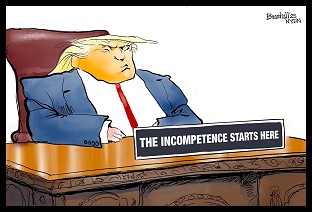 Sunday 'Great Start!' Toons
Sunday 'Great Start!' Toons Vets Push Back at Trump, Musk Plan to Slash Health Care, 80K V.A. Jobs: 'BradCast' 3/27/25
Vets Push Back at Trump, Musk Plan to Slash Health Care, 80K V.A. Jobs: 'BradCast' 3/27/25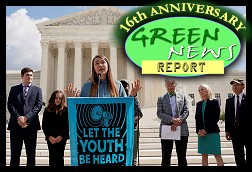 'Green News Report' 3/27/25
'Green News Report' 3/27/25
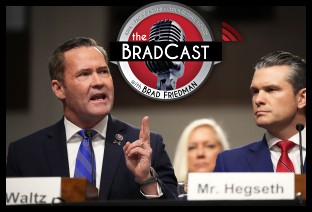 Signal Scandal Worsens for Trump, GOP; Big Dem Election Wins in PA: 'BradCast' 3/26
Signal Scandal Worsens for Trump, GOP; Big Dem Election Wins in PA: 'BradCast' 3/26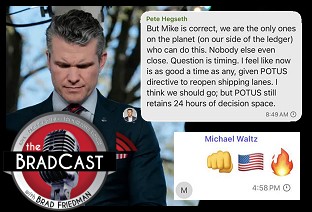 'Emptywheel' on Why Trump NatSec Team Should 'Resign in Disgrace' After Signal Chat Debacle: 'BradCast' 3/25/25
'Emptywheel' on Why Trump NatSec Team Should 'Resign in Disgrace' After Signal Chat Debacle: 'BradCast' 3/25/25 'Green News Report' 3/25/25
'Green News Report' 3/25/25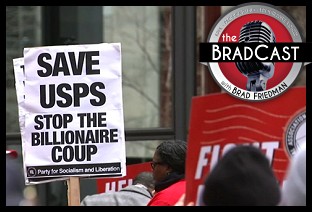 USPS 'Belongs to the People, Not the Billionaires': 'BradCast' 3/24/25
USPS 'Belongs to the People, Not the Billionaires': 'BradCast' 3/24/25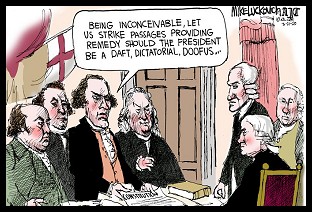 Sunday 'Suddenly Conceivable' Toons
Sunday 'Suddenly Conceivable' Toons 'Green News Report' 3/20/25
'Green News Report' 3/20/25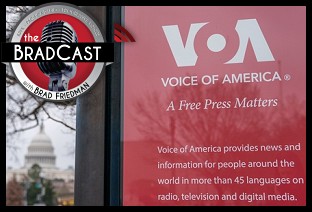 We're ALL Voice of America Now: 'BradCast' 3/20/25
We're ALL Voice of America Now: 'BradCast' 3/20/25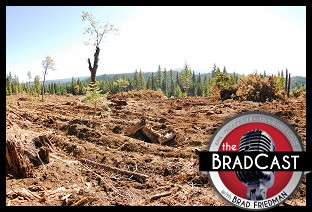 What Trump's 'Timber Production Expansion' Means (and Costs): 'BradCast' 3/19/25
What Trump's 'Timber Production Expansion' Means (and Costs): 'BradCast' 3/19/25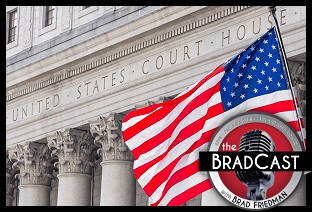 Courts Largely Holding Against Trump, Musk Lawlessness: 'BradCast' 3/18/25
Courts Largely Holding Against Trump, Musk Lawlessness: 'BradCast' 3/18/25 Chief VOA Reporter on Outlet Falling Silent First Time Since 1942: 'BradCast' 3/17/25
Chief VOA Reporter on Outlet Falling Silent First Time Since 1942: 'BradCast' 3/17/25 Trump EPA Unveils Plans to Endanger, Sicken Americans: 'BradCast' 3/13/25
Trump EPA Unveils Plans to Endanger, Sicken Americans: 'BradCast' 3/13/25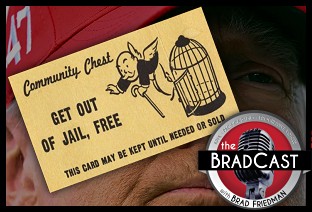 Trump Nixed Enforce-ment Against 100 Corp. Lawbreakers: 'BradCast' 3/12/25
Trump Nixed Enforce-ment Against 100 Corp. Lawbreakers: 'BradCast' 3/12/25 Bad Day for 'Strongmen': 'BradCast' 3/11
Bad Day for 'Strongmen': 'BradCast' 3/11 WI Election Could Flip Supreme Court Control, Musk Jumps In: 'BradCast' 3/10
WI Election Could Flip Supreme Court Control, Musk Jumps In: 'BradCast' 3/10
 VA GOP VOTER REG FRAUDSTER OFF HOOK
VA GOP VOTER REG FRAUDSTER OFF HOOK Criminal GOP Voter Registration Fraud Probe Expanding in VA
Criminal GOP Voter Registration Fraud Probe Expanding in VA DOJ PROBE SOUGHT AFTER VA ARREST
DOJ PROBE SOUGHT AFTER VA ARREST Arrest in VA: GOP Voter Reg Scandal Widens
Arrest in VA: GOP Voter Reg Scandal Widens ALL TOGETHER: ROVE, SPROUL, KOCHS, RNC
ALL TOGETHER: ROVE, SPROUL, KOCHS, RNC LATimes: RNC's 'Fired' Sproul Working for Repubs in 'as Many as 30 States'
LATimes: RNC's 'Fired' Sproul Working for Repubs in 'as Many as 30 States' 'Fired' Sproul Group 'Cloned', Still Working for Republicans in At Least 10 States
'Fired' Sproul Group 'Cloned', Still Working for Republicans in At Least 10 States FINALLY: FOX ON GOP REG FRAUD SCANDAL
FINALLY: FOX ON GOP REG FRAUD SCANDAL COLORADO FOLLOWS FLORIDA WITH GOP CRIMINAL INVESTIGATION
COLORADO FOLLOWS FLORIDA WITH GOP CRIMINAL INVESTIGATION CRIMINAL PROBE LAUNCHED INTO GOP VOTER REGISTRATION FRAUD SCANDAL IN FL
CRIMINAL PROBE LAUNCHED INTO GOP VOTER REGISTRATION FRAUD SCANDAL IN FL Brad Breaks PA Photo ID & GOP Registration Fraud Scandal News on Hartmann TV
Brad Breaks PA Photo ID & GOP Registration Fraud Scandal News on Hartmann TV  CAUGHT ON TAPE: COORDINATED NATIONWIDE GOP VOTER REG SCAM
CAUGHT ON TAPE: COORDINATED NATIONWIDE GOP VOTER REG SCAM CRIMINAL ELECTION FRAUD COMPLAINT FILED AGAINST GOP 'FRAUD' FIRM
CRIMINAL ELECTION FRAUD COMPLAINT FILED AGAINST GOP 'FRAUD' FIRM RICK SCOTT GETS ROLLED IN GOP REGISTRATION FRAUD SCANDAL
RICK SCOTT GETS ROLLED IN GOP REGISTRATION FRAUD SCANDAL VIDEO: Brad Breaks GOP Reg Fraud Scandal on Hartmann TV
VIDEO: Brad Breaks GOP Reg Fraud Scandal on Hartmann TV RNC FIRES NATIONAL VOTER REGISTRATION FIRM FOR FRAUD
RNC FIRES NATIONAL VOTER REGISTRATION FIRM FOR FRAUD EXCLUSIVE: Intvw w/ FL Official Who First Discovered GOP Reg Fraud
EXCLUSIVE: Intvw w/ FL Official Who First Discovered GOP Reg Fraud GOP REGISTRATION FRAUD FOUND IN FL
GOP REGISTRATION FRAUD FOUND IN FL

































